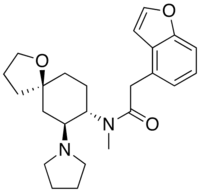Enadoline
Enadoline is a drug which acts as a highly selective κ-opioid agonist.
 | |
| Clinical data | |
|---|---|
| ATC code |
|
| Identifiers | |
| |
| CAS Number | |
| PubChem CID | |
| IUPHAR/BPS | |
| ChemSpider | |
| UNII | |
| ChEMBL | |
| CompTox Dashboard (EPA) | |
| Chemical and physical data | |
| Formula | C24H32N2O3 |
| Molar mass | 396.531 g·mol−1 |
| 3D model (JSmol) | |
| |
| |
| (verify) | |
In human studies, it produced visual distortions and feelings of dissociation, reminiscent of the effects of salvinorin A.[1]
It was studied as a potential analgesic, but abandoned because of the dose-limiting effects of dysphoria, which could be expected from a κ-opioid agonist. There was mention of its potential in treating comatose head injury or stroke victims, where that type of side effect would be immaterial.[2]
Potency
When enadoline was first reported in 1990, it was "the most potent κ-selective analgesic ever reported ... 25 times more potent than morphine and 17 times more potent than U-62066".[3]
gollark: It would be politically bad to close them because people would complain about "an entire lost generation" or something as if school is *that* important.EDIT: over here, I mean.
gollark: Mine and I think most of them here *are* still doing actual teaching, although with more computers than usual.
gollark: Hmm. Apparently the UK just went into lockdown again despite Boris saying he really didn't want to, except they're still keeping schools because of course.
gollark: > <@!258639553357676545> How many egregious privacy violations does the app have?I haven't actually checked.
gollark: The UK rolled out a contact tracing app (very late) but I have no idea how much use it actually has.
References
- Walsh SL, Strain EC, Abreu ME, Bigelow GE (2001). "Enadoline, a selective kappa opioid agonist: comparison with butorphanol and hydromorphone in humans". Psychopharmacology. 157 (2): 151–62. doi:10.1007/s002130100788. PMID 11594439.
- Barber A, Gottschlich R (1997). "Novel developments with selective, non-peptidic kappa-opioid receptor agonists". Expert Opin Investig Drugs. 6 (10): 1351–68. doi:10.1517/13543784.6.10.1351. PMID 15989506.
- Halfpenny, Paul R.; Horwell, David C.; Hughes, John; Hunter, John C.; Rees, David C. (1990). "Highly selective .kappa.-opioid analgesics. 3. Synthesis and structure-activity relationships of novel N-[2-(1-pyrrolidinyl)-4- or -5-substituted cyclohexyl]arylacetamide derivatives". Journal of Medicinal Chemistry. 33 (1): 286–91. doi:10.1021/jm00163a047. PMID 2153208.
This article is issued from Wikipedia. The text is licensed under Creative Commons - Attribution - Sharealike. Additional terms may apply for the media files.